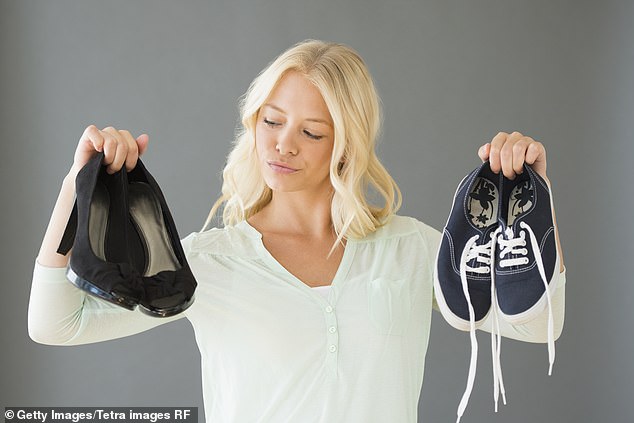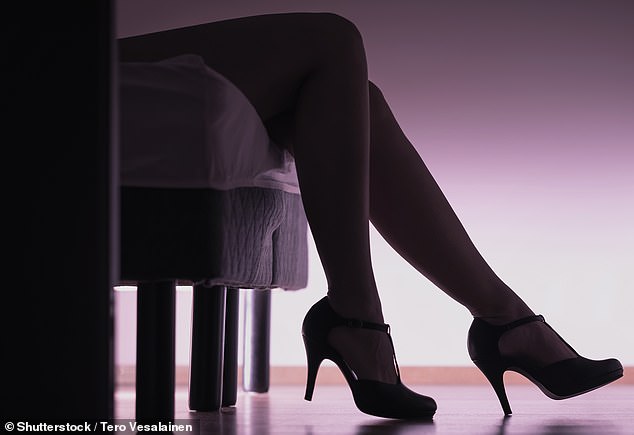Revealed: Why women are ditching stilettos for flats as sales of high heels fall by half
New research from shoe retailer Kurt Geiger shows that sales of shoes with a heel of four inches or higher have declined in recent years.
Shoes with a heel of four inches or higher accounted for almost half (47 percent) of all sales of shoes without a flat heel.
However, these more dazzling styles still only account for one-sixth (17 percent) of purchases in that particular sector.
At the same time, the number of shoes with a heel of only two inches (generally considered “average” height, rather than high) has doubled, and more people are opting for shoes such as ballerinas and loafers.
And according to The sundaypapersThere could be several reasons for this shift, not just related to changes in fashion.
The lockdown could be a major factor why more women are opting for flatter shoes instead of stilettos these days (stock image)
According to the outlet, some podiatrists believe that the Covid-19 disease is the cause of the illness. lockdown could partly explain the sales figures.
These experts say that wearing flip-flops and slippers more often during the lockdown has led to the spread of foot infections in some people.
Wearing flat, more comfortable, less structured shoes also caused some people’s feet to become softer and wider.
Wearing shoes with heels, which have more structure, becomes more uncomfortable and difficult.
Even though lockdown is long over, many people still haven’t returned to their pre-2020 shoe habits, even when wearing smarter outfits.
That’s according to Rebecca Farrar-Hockley, creative director of Kurt Geiger.
She told the Sunday Times that many people are looking for comfort, even in ‘smarter’ outfits.
‘Our customers now seem to be opting more for ‘occasion wear’ that offers both length and comfort, with platform soles and platform sandals being the big winners, closely followed by dainty, colourful ballerina flats and brightly coloured loafers,’ she said.

According to Rebecca Farrar-Hockley (not pictured), creative director of Kurt Geiger, many people are looking for comfort even when wearing “dressier” outfits (stock image)
Rebecca added that the trend is nationwide, noting that flats are outperforming heels across the UK.
However, the research shows that there are certain areas where the shoes are higher than others.
It is striking that in Milton Keynes, 31 percent of heels sold still fall into the 10cm and over category, which is considerably higher than the national average of 17 percent.
In Newcastle too, shoe lovers seem to be keen to hold on to their ultra-high heels, which account for around 26 per cent of sales in the heels category.
It’s not just comfort that could be playing a role in the sales changes: the revival of early 2000s trends, particularly the preference for kitten heels, could also be driving some people to opt for lower-heeled styles.
This current preference for low-heeled shoes may be good news for the health of some people’s feet.
Research from 2008, as ‘killer heels’ became increasingly popular, found that wearing such shoes for long periods of time could cause a number of problems.
High heels in the form of stilettos first became popular in the 1930s. In the past, heels were mainly worn for special occasions, but thanks to the success of series such as Sex And The City, it has become more common to wear high heels every day.

Wearing heels four inches or higher every day became more popular after the trend for lower “kitten” heels in the early 200s. But now the trend of wearing shoes with lower kitten heels is making a comeback, according to market research data (stock image)
But the problems that daily wear can bring, and which can be permanent, range from hammertoes and bunions to irreparable damage to the tendons in the legs.
Many of the problems – which can occur simultaneously – are caused by the increased pressure that high heels put on the ball of the foot; the higher the heel, the greater the pressure. The knee and back can also be affected.
When this research was published, podiatric surgeon Mike O’Neill said: ‘High heels cause you to lift your heel and push your center of gravity forward.
“What happens then is that you arch your lower back to compensate. This changes the position of your spine and puts pressure on the nerves in your back.”
This can cause sciatica, a painful condition in which nerves become pinched, causing pain and numbness down to the feet.
Another common problem, Mike says, is that the Achilles tendon, which runs from the heel down the back of the leg, becomes permanently damaged.

There is research to support the theory that wearing heels 3 inches or higher more than a few times a week can cause a number of physical problems, some of which may be irreversible (stock image)
‘This tendon is designed to be flexible, allowing the foot to lie flat or point. But many women who wear high heels too often experience a shortening of the tendon, because the heel tightens as it points upward. It can be very painful to stretch it again.
‘If you try to put your foot in flat shoes, you get a lot of pain at the back of the heel. I’ve seen 70-year-olds still walking around in high heels because they can’t put their feet flat anymore, it’s just too painful.’
This latest trend for low-heeled shoes can help you avoid these problems.
According to the podiatrist, most women can prevent damage to their Achilles tendon by not raising their heels higher than 4 cm.
Heels that are only 3 inches or higher and that you wear more than once or twice a week can shorten the Achilles tendon.
